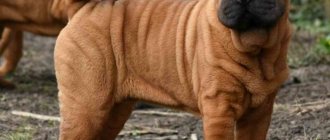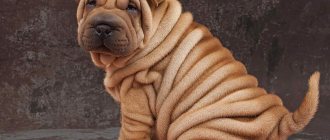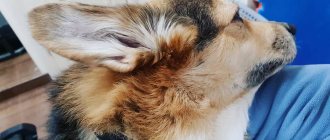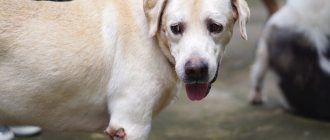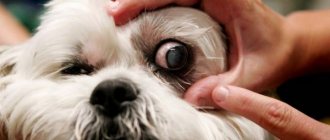Video
* We invite you to watch a video about the Shar Pei . In fact, in front of you is a playlist in which you can select and watch any of 20 videos about a given dog breed by simply clicking on the button in the upper right corner of the window. In addition, the material contains quite a lot of photos. By looking at them you can find out what a Shar Pei looks like.
In this article:
|
Rate the material!
[Total votes: 3 Average: 5]
The Shar Pei is a compact, robust, medium-sized dog with very short hair. It is easily recognized by the wrinkles on its head and fur. The Shar Pei is a breed that requires a lot of love, affection and attention. This is not a very athletic dog. One outing per day is enough for him. He is very smart, easy to train and sociable. He has good health, so the Shar Pei is an active dog.
Shar Pei breed standard
The Shar Pei is a medium-sized dog with a dense, strong build. At the withers 45-50 cm, weight in the range of 17-26 kg, males are much larger and more powerful than females. What immediately catches your eye is the large head, which may seem somewhat disproportionate to the body. The muzzle is wide, square, all covered with folds. Excess skin is the highlight of the Shar Pei; puppies are completely covered with folds; as the dog grows, they go away, but remain on the face, neck, and scruff of the neck. The eyes are medium-sized, almond-shaped, set close together, and the overhanging eyebrows make the look appear gloomy. The nose is wide, black or six-colored, and may have a tubercle. The tongue, palate and gums are dark blue or purple, sometimes the tongue is pink-blue, spotted, but pure pink is unacceptable. The jaw is powerful and has a scissor bite. The ears are small, triangular, set high but wide, pressed to the head, the ends directed towards the eyebrows - erect are unacceptable. The tail is set high, wide at the base, tapering towards the end, curved upward towards the back in the form of a crescent or in a ring. The limbs are straight, without folds. The coat is hard, dense, straight, without undercoat. The color can be any except white.
History of the origin of Shar Peis
Archaeological finds indicate the existence of the breed back in Ancient China. Dogs with the appearance of a Shar Pei were represented in figurines of the Han Dynasty around 200 BC. e. Shar Peis were traditionally bred by Chinese farmers in the coastal regions of the country's south. They highly valued their work as hunting and garden dogs.
Later, the Shar Pei was trained to fight, but other, more powerful and aggressive breeds gradually replaced it. Lack of interest in the breed almost caused it to disappear, but pastoralists from neighboring countries (Hong Kong, Taiwan) retained a few individuals.
Interesting fact: The Shar Pei is primarily a country dog, bred for hunting and keeping a herd. However, his physical qualities quickly turn him into a fighting dog, which is highly valued by peasants and workers.
Less useful in combat, the Shar Pei was on the verge of extinction. When China became a communist country, a tax was introduced that made dog ownership a luxury beyond the reach of farmers. In 1947, the tax was increased and dog breeding was prohibited. In 1978, the Shar Pei was included in the Guinness Book of Records as the rarest dog in the world.
American and British breeders were able to import a few Shar Peis to breed them. The Shar Pei arrived in Europe in the 1980s and made significant progress there, but this was not enough to save it from extinction. While the breed almost went extinct in the mid-1900s, a few enthusiasts managed to escape it, and the Shar Pei is now a fairly popular breed.
History of the origin of the breed
The Shar Pei dog is a native Chinese: the birthplace of the breed is the city of Dailak. Dog figurines with recognizable characteristics were found during excavations of buildings, the construction of which archaeologists date back to the 3rd century BC. This breed is believed to have common ancestors with the Chow Chow and Mastiffs.
Shar-Peis bred to participate in dog fighting are adapted for defense and attack : powerful jaws are capable of inflicting serious wounds, folds on the body and head do not reduce mobility, but protect from injury, prickly hair causes discomfort to the opponent when bitten.
The history of Shar Peis goes back more than three thousand years. During this time, they managed to try out security, guard and hunting functions. Fighting dogs were used in hunting large game that was ready to fight for life: wolves, wild pigs, and feline predators.
Gradually the breed became popular pets. They were equally loved to be kept both in the houses of the nobility and in the huts of peasants. They hunted with dogs, guarded livestock and property.
The ancient ancestors of Shar Peis were distinguished by high intelligence, strength, distrust of strangers, and endurance. Such qualities were passed down from generation to generation and over time transformed into a universal service dog, equally good at guarding the house and hunting big game.
There was a fashion for Shar-Peis among the upper class. They basked in the houses of nobles, served with the equanimity of a monk at temples, and were endowed with royal powers in the imperial palaces.
This continued until the 13th century. Then the empire became mired in wars and conflicts. Breeding has become an unaffordable luxury. At the end of the 18th and beginning of the 19th century, interest in Shar Peis reappeared, but the coming to power of the Communist Party in the mid-20th century almost put an end to the existence of the breed.
Animals were mercilessly destroyed - yesterday's peasants, who stood at the helm of power, considered pets a symbol of the aristocracy. Several dogs ended up in the United States at this time; a few Shar Peis remained on the island of Taiwan and Macau.
In the 1970s, a sad entry appeared in the Guinness Book of Records: “Shar Peis are the rarest dog breed in the world.”
American dog breeders, in an attempt to preserve the breed, were forced to resort to mixing Shar Peis with related breeds and inbreeding.
The American Kennel Association registered the restored breed as the "Chinese Fighting Dog" in 1971 and adopted a standard in 1976. Five years later, Shar Peis were recognized by the International Canine Federation.
Shar Pei - description of the breed
The obvious contradictions in the Shar Pei's personality make him a very special dog. In terms of body type, this purebred dog is also not quite ordinary. It meets the Chinese standard: "Shell-shaped ears, a butterfly-shaped nose, a melon-sized head, a grandmother's face, a hippopotamus neck, a horse's hindquarters, and a dragon's paws."
The wrinkles on the Shar Pei's head and back are striking. However, characteristic wrinkles should not be reproduced “artificially”, as was often the case in the past. The Shar Pei was originally a working dog whose freedom of movement should not be limited by excessively thick skin. Today, excess wrinkles are usually only found in puppies whose coats appear too large for their small bodies. Only when they reach adult size do they have only a few wrinkles on their head and fur.
Males reach a height of up to 51 cm, females are slightly smaller, with a maximum height of 48 cm. Depending on the size, the weight of an adult Shar Pei should be between 18 and 25 kg. The modern Shar Pei seems a little more massive than its ancestors. Their appearance is enhanced by their large heads. Typical shell-shaped ears appear very small in comparison. The Shar Pei is also characterized by its rooster tail and blue tongue, indicating its common ancestry with the Chow Chow.
The physical characteristics of the Shar Pei are:
- The coat is harsh, very short and bristly, straight (except on the limbs) and without undercoat;
- Solid color, perhaps with lighter shades on the tail and back of the thighs. With the exception of white, all coat colors are possible;
- The head is large in relation to the body. The skull is flat and wide. Wrinkles on the forehead and cheeks expand, forming a teardrop. The characteristic muzzle resembles that of a hippopotamus;
- The ears are in the form of very small triangles, the ends of which are slightly rounded. They are thick and should not be vertical;
- The eyes are almond and dark, they are distinguished by a frowning expression;
- The top line of the body drops slightly downwards. The chest is quite wide, the lower line goes up and to the side;
- The tail is thick at the base, becoming thinner as it approaches the end. It is attached high, curved, tightly twisted.
Description of the breed
Initially, the Shar Pei dog breed was classified as a guard dog. Strong, muscular dogs are still used as service animals.
The numerous folds that make a dog unique are also not accidental. These subcutaneous deposits in the Shar Pei are protection from other animals in battles.
Shar Peis are of the Molossoid type. The weight of the cable varies from 30 to 35 kg, females weigh a little less - 25-28 kg. The size of an adult dog at the withers is 48-52 cm.
There are 4 main subspecies of Shar Pei, which are considered standards: Chinese, American, Canadian and English. Of all the breeds, only the Canadian is significantly different from the others: the dog’s height is 7 cm less, and the palette of colors is larger.
According to the description of the breed, they are united by the following characteristics:
- small eyes;
- triangular-shaped ears, pressed firmly to the head;
- hard short coat without undercoat;
- monotonous color with a dark mask on the face.
Popular Shar Pei colors
The Shar Pei has many possible coat colors. All colors are allowed except white. The solid coat varies from dark black to soft gray or bright reddish brown to light sand and cream. Dark shades on the back, ears and tail are also possible. In any of the possible variants, the Shar Pei's coat is short, hard and bristly. The dog has no undercoat that could keep it warm. As a result, the Shar Pei does not tolerate cold and humidity.
The American Kennel Club has recognized 16 acceptable colors for the Chinese Shar Pei dog. The most common ones are black, fawn and even tan. The breed comes in shades of blue, cream, red-fawn, apricot, and chocolate. Some Shar-Peis also have what are called color markings. This means that the dog has spots of different shades on its black coat. The Shar Pei can also be diluted, which means the dog's paws and nose are the same color as its body. This monotone is one of the characteristics that contribute to the rarity and uniqueness of the Shar Pei.
Fun fact: Shar Peis are not hypoallergenic, but they do shed less hair compared to other dogs. They molt about two or three times a year. A distinctive feature of Shar Peis is their tongue, which has shades of black and blue.
Shar Peis are easy to maintain, and contrary to what people think about them, their folds do not require much care. With normal dog care, vaccinations, deworming, flea treatment, bathing and general good care, they will enjoy good health. They do not feel difficulties with their skin and coat, the length of which does not require combing. Pay attention to the ears as they can become dirty due to lack of air circulation.
Character and habits of Shar Peis
The Shar Pei is a calm and loyal dog with an irresistibly sweet appearance. However, he is not without temperament, sometimes very capricious, stubborn, dominant and even aggressive. He needs training to prevent the development of behavioral problems and the ability to be unpredictable. However, even timely upbringing does not erase his character traits, which can only be directed towards a suitable lifestyle.
Socialization is very important in raising this dog. This is a step that will allow him to develop more balanced and measured behavior. The Shar Pei should be educated, gentle, logical and firm from an early age.
Shar Pei are less tolerant of other animals. When he meets other dogs, he tends to forget his natural calmness and sometimes exhibits dominance behavior. Therefore, early and complete socialization, empathic and consistent education are absolutely necessary for this breed. With good training, this smart and proud dog will learn to control himself and not succumb to provocations.
To become a sociable companion dog, the sensitive Shar Pei not only needs a good education, but also a close bond with its family. He will quickly develop his own ideas and ways of behaving that will not necessarily satisfy his owner. But if his family is close to him, they will be rewarded with great loyalty on the part of the Shar Pei. In the company of his family, a very serious Shar Pei can be cheerful and gentle.
In addition, the Shar Pei is considered a reliable guard dog that always carefully and confidently protects its family. Although he is reserved when meeting strangers for the first time, the Shar Pei is brave and confident enough to protect his family if the situation calls for it. The owner must show the pet when there really is danger, and he can relax. It's good to have some training know-how and good control over the dog. One thing is for sure: there will be no dull moment with this multifaceted dog.
Advantages and disadvantages
Benefits of Shar Pei:
- Small dimensions.
- Service qualities.
- Devotion to the owner.
- High intelligence.
- Easy care, cleanliness.
- Calm character.
Disadvantages of Shar Pei:
- Problems with training and gaining authority.
- Scrupulousness in choosing food.
- Aggression towards foreign animals.
- Short life expectancy.
Interesting facts about Shar Peis
The Shar Pei is a very recognizable dog due to the folds that cover its entire body. This feature gives the breed a unique appearance in addition to its stocky build. Loyal and gentle, the Shar Pei is an ideal companion for both children and seniors. This is a dog that is especially pleasant to live with because it loves the comfort of its home as well as long walks.
Shar Pei can live in the city and in an apartment. This is a calm dog that does not require much physical activity and gets up early enough. He doesn't like rain or cold and prefers to lie in his basket or on the couch.
The Shar Pei has difficulty withstanding physical limitations, which is why it does not always have a good reputation among veterinarians. In some cases, he may panic, threaten, or be close to suffocation. His reaction may not seem realistic, but his stress is real. In these cases, you need to change the way you examine it. He will feel and behave much better if he understands what is happening. It is important to accustom him to manipulation from an early age, associating it with something pleasant, including to facilitate visits to the veterinarian.
Although he may seem completely independent, the Shar Pei's attachment to his human is very real. Some Shar Peis enjoy the company of other dogs, and some do not. As a rule, the Shar Pei is a very calm dog.
Pros and cons of Shar Peis
Since the Shar Pei is a quiet and calm dog, it can live in an apartment (walked several times a day) or in a house with a fenced backyard. It adapts to both the city and the countryside if the owner gives it enough time. All family situations are suitable for this breed. It is well compatible with small children. The Shar Pei is also suitable for older people.
Shar Peis love to live in open spaces in rural areas as well as suburban areas, and are equally happy living in an apartment. They excel at obedience and love to please their owner, making them very enjoyable to train. Shar Peis are called Chinese fighting dogs. But this is a mistake because the Shar Pei is not a dog that seeks conflict with other animals, however, it reacts quickly if it is attacked.
The Shar Pei is one person's dog, but in family life he will love everyone. He builds special relationships with people. The ideal owner will appreciate this breed's loyalty and respect its need for calm in new situations. He needs exercise, socialization, love and attention to be happy and balanced.
The Shar Pei is not a great athlete, but he needs exercise to stay in shape. This is a calm dog, which is better suited for calm and non-athletic people. Since the Shar Pei is extremely attached to its owner and does not tolerate loneliness, its owner should not be constantly absent.
Thus, the positive traits of Shar Peis are:
- The dog is suitable for a loyal family, gets along very well with children;
- Quiet indoors, can live in an apartment;
- An excellent watchman;
- He needs a moderate amount of exercise;
- Barks a little.
Negative aspects of Shar Peis:
- Has aggressive potential towards strangers if not introduced to people at a young age;
- Stubborn and dominant, which can make learning difficult;
- Does not tolerate loneliness, requires a lot of attention and human presence;
- Dear dog (for purchase and veterinary services);
- Not recommended for beginners;
- Tends to drool, especially if his lips are saggy.
Shar Pei character
Shar Peis are very smart dogs, perhaps this is their main advantage. The puppy may only live with you for a few days, but it will already remember what can and cannot be done.
You might argue that all dogs are smart. Yes it is. But, according to Shar Pei owners, their pets are truly wise. Remember that the behavior of a pet of a given breed is a reflection of your attitude towards it. If you are careless with your dog and pay little attention, your pet will immediately pretend that he has forgotten about you.
Shar Pei quickly learn to distinguish between “us” and “stranger”. In the family, they are always ready to recognize the leader and will not claim the main role. It is important that the Shar Pei cannot be deceived. He always recognizes the motive hidden behind a piece of treat in someone else's hand.
These dogs are kind and affectionate, but if they sense danger, they immediately transform. The dog's temperament is suitable even for pensioners. Need to run in the morning? Please! Need to sleep in the morning? No questions asked either! A dog of this breed knows how to adapt to its owners.
By character, he is a canine aristocrat: smart, proud, with a balanced psyche, not giving excessive free rein to emotions, with a serious expression on his face. At the same time, he is quite mobile and active, a wonderful and devoted guard. He carefully monitors his toilet, which is important for living in apartment conditions. Regarding walks, the Shar Pei requires a very long walk.
We advise you to read: Pug Dog Breed
As a rule, Shar-Peis are as healthy as their appearance. But there is one thing: due to the specific characteristics of the breed, there is a predisposition to an unpleasant disease, expressed in turning the eyelids inward (entropion), the consequences of which can be very sad, even blindness.
The Chinese Shar Pei can be described as a highly intelligent, independent dog with dignity. They can be unfriendly with strangers, but are devoted to their family. Despite their dissatisfied and gloomy expression on their faces, Shar Peis are very sociable dogs.
Shar Peis are endowed with an original character by nature. They are not as phlegmatic as many people think. Since childhood, they have a choleric temperament. Only with age does Shar Pei become calmer, wiser and more reasonable. He is perfect for the role of a family pet. Shar Peis are loyal, independent, loyal and friendly animals. The Shar Pei's small size makes it an ideal apartment dog. Despite their appearance, they are fearless and strong, ready to defend their master to the last. Also, if desired, they can be taught to catch mice.
Shar Peis are considered good family dogs, however they can be aggressive towards other dogs and are not always patient enough with children, which can be corrected by early socialization and keeping their aggression to a minimum. Shar Peis are loyal to their owner and family members.
Shar Peis have an extremely dominant and independent nature and prefer to be the king or queen of the house, so it is important that they know who is boss. If the owner of the Shar Pei is unsure of himself, is too soft or is afraid of his dog, the Shar Pei will quickly take on the function of the leader and become dominant.
There is an opinion that Shar Pei dogs are better suited for experienced owners. They will also not listen to family members whom they do not consider more important than themselves. For this reason, it is important for all family members to establish a leadership position in relations with the Shar Pei early in its life.
Shar-Peis do not like water and will avoid bathing, so it is best to teach Shar-Peis this procedure from an early age.
When buying a Shar Pei, pay attention to the breed line. There was an overproduction of Shar Peis in the 1980s, therefore the personality and health of a Shar Pei will depend on the dog's genetics. If you carefully study the pedigree of a Shar Pei, you can usually determine whether a given dog will be aggressive towards other dogs or not.
Breeding Shar Peis
Breeding Shar-Peis is an amazing adventure because they are one of the rarest dog breeds in the world. They are rare, friendly, sweet and obedient. They are easy to train and quite healthy. Shar Pei breeding only requires a genuine pedigree of the dog. The Shar Pei is expensive and requires a lot of attention.
You need to understand that these dogs have some potential complications, such as dermatitis, which affects the folds of the skin. Familial Shar Pei fever also plagues the breed. An ethical and responsible Shar Pei breeder needs to develop their own pedigree with the highest possible health screening.
Shar Pei breeding dates back to the pre-Christ era, despite the fact that at that time the breed had a completely different appearance. From a fighting dog to a family and child-friendly breed, the breed has undergone a great evolution. The Shar Pei originates in southern China, somewhere in the Hunan province. Some old references to the breed even suggest that the breed has been around since 200 BC. e.
The Shar Pei gives birth to 4-6 puppies at a time. In some exceptional cases, the litter size may increase to 8 or 9. Even a miniature Shar Pei can give birth to 4-6 puppies at a time. A Shar Pei breeder must be willing to care for the puppies. Cleaning their ears is of utmost importance to them. After the birth of the litter, you need to check it for the presence of genetic diseases. This will make it possible to influence them at an early stage and avoid as many diseases as possible.
The Shar Pei is generally a healthy breed with no reproductive trauma. Their pregnancies are generally easy without problems. The only thing that might pose a threat to them is that their small bodies have slightly narrow birth canals. The Shar Pei is muscular and its puppies are overly wrinkled. This can lead to a painful and difficult birth. It is not uncommon for a Shar Pei breeder to use a caesarean section, but this is sometimes avoided for medical reasons.
Shar Pei care
Shar Peis are a dog breed that requires minimal grooming. All you need to do is brush your Shar Pei regularly to remove dead hair. The only thing you should pay special attention to is the Shar Pei's ears. It is important to never wash your Shar Pei's hair. Water getting into the Shar Pei's ears causes serious problems that are not seen in other dog breeds. These dogs have very thin ear canals and can develop serious ear infections if exposed to water.
A Shar Pei should be bathed approximately once a month. A rubber brush can be useful in the bath to remove loose hair. It is better to use special shampoos for dogs, because human shampoos and liquid soap can cause skin irritation. This is extremely important for dogs of this breed because skin irritation and skin diseases are common in Shar-Peis. Rinse the Shar Pei's folds well with shampoo.
Drying after a bath is also important for this breed. It is important to dry the skin well between the folds of the Shar Pei; this can be done with a hairdryer. You can also use baby powder or special powder for dogs to remove excess moisture from their folds and avoid irritation.
We advise you to read: Entlebucher Sennenhund Dog Breed
Shar Peis need significant exercise. Long walks and lots of exercise outside will make your Shar Pei calmer at home. The Shar Pei's head is very sensitive to overheating, so in very hot weather it is better to limit the Shar Pei's active stay outside. Although Shar-Peis tolerate cold better than heat, a temperate climate is ideal for this breed.
Shar Pei training must begin from a very early age. Since Shar Peis are prone to aggression towards other dogs, it is important to give them the opportunity to spend plenty of time with other animals starting at an early age. They are generally playful and good with children, but again, subject to good socialization among children during puppyhood.
However, Shar Peis can sometimes be very stubborn and independent, which makes training them not a very easy task.
They rarely get sick and can withstand bad weather, cold or heat well. You can walk with your pet for only 15 minutes if you don’t have time.
Please note that these dogs are very clean, so their territory should always be cleaned. There are no special difficulties in caring for these pets. Caring for a Shar Pei is quite simple.
Shar Pei care
The Shar Pei is a dog that does not require special care. Its short and hard coat tends to clean itself and only needs to be brushed with a cloth or brush. Contrary to popular belief, Shar Pei wrinkles are generally not a problem to care for. However, the precondition for this is that the wrinkles are not too pronounced and are present only on the head and back, as required by the standard.
Important fact: Excessive wrinkles in a Shar Pei from intensive breeding require constant monitoring and frequent cleaning, as the skin can easily become inflamed.
The Shar Pei is as undemanding in terms of physical activity as it is in terms of grooming. This sloth refuses to be overexerted, which is why it is rare to see the Shar Pei in dog sports. However, it is necessary to give him some exercise every day, especially to avoid excess weight. If daily walks vary slightly and the dog has time to quietly "sniff" his surroundings, the Shar Pei will be motivated to take long walks. But this only happens until it rains or snows too much, because dogs don’t like cold or water at all.
The Shar Pei is a dog that gets tired very quickly, its training should be very short and stop before the puppy decides not to listen to its owner anymore. It is necessary to observe your pet to find its Achilles heel: is it more responsive to affection, stimulation or sweet treats? Once the owner has the right motivation lever in his hands, it will be easy for him to train the Shar Pei, as well as motivate him to obey and complete all tasks.
Despite his strong character, an adult Shar Pei can always learn on his own, especially when his owner has discovered how to please him. However, this is not a dog that will respond to stupid orders just to please its owner. You should ask him only what he needs before exploring whether his temperament is conducive to performing other tricks. Due to its complex nature, the Shar Pei is best educated with the support of a professional trainer.
Shar Pei diet
A puppy that has passed all the necessary tests and has no hereditary diseases certainly has a good chance of living a long and healthy life. However, the age and agility of a Shar Pei will depend not only on its DNA, but also on education, care and diet. Like any other dog, the Shar Pei should receive a balanced, high-quality diet.
It is important to be careful that your dog is getting the right amount of protein. Protein is the most important source of energy for dogs and should always be present in your Shar Pei's bowl. However, excess protein can cause kidney and joint problems in this breed. As a source of protein, you can choose meat or fish, which are easy to digest, and accompany them with plenty of vegetables.
A Shar Pei's exact nutritional needs will depend on its age, health, weight and activity level. For example, a food that is best for a certain Shar-Pei may not be adequate for another. If in doubt, you can ask your veterinarian, breeder or nutritionist which formula is best for your particular pet.
The Shar Pei has a massive head, muzzle and a short upper jaw. Thus, the dog's chewing is limited and he tends to swallow food without chewing it. To avoid digestive problems, it is important to divide your Shar Pei's daily diet into two meals a day. Until the age of 6 months, he needs to receive 3 meals a day.
Fun fact: Shar Peis are generally considered lazy dogs that need a little exercise. Thus, many of them are overweight, which can lead to serious health problems. An adult dog should be fed a maximum of twice a day and treats should be avoided between meals. It is also important to make sure he always has enough fresh water.
The dietary needs of a Shar Pei is a simple and balanced diet. Particular care should be taken to avoid artificial colors, preservatives and red meat. Other ingredients that should not be given to your dog are corn and soy products. They can lead to allergic reactions in this breed.
Character and habits
The character of Shar Peis, according to many dog handlers, is quite balanced, but at the same time willful, and a Shar Pei puppy definitely needs training. You can meet very kind, affectionate and playful dogs of this breed, although there are exceptions to every rule. In any case, you need to exercise your Shar Pei, walk the dog regularly (at least twice a day) and play at least once a day. Having recognized the owner as a leader, the animal will willingly carry out commands and also protect the person with complete dedication.
Diseases and health problems
Shar Peis are generally healthy, happy, and have a temperamental temperament. They are ideal for both dog owners and families. Their short but muscular shape makes them good friends for children. The Shar Pei can adapt to small spaces as it is a medium-sized pet. One of the main problems of Shar-Peis is their life expectancy. The Shar Pei has a very short life - from 9 to 11 years. This is almost 5 years shorter than most other dogs.
The Chinese type of Shar Pei, that is, the original one, is not as wrinkled as the American type, in which the wrinkles are too accentuated. Even if they give the dog the special look that led him to success, excessive wrinkles cause problems with the skin: it is easily irritated and becomes a victim of infections, parasites, etc. Like all dogs with a very large head compared to the body, females may have problems giving birth.
The Shar Pei dog is robust, but still has some predispositions to health problems, mainly due to the skin and the many folds that make up it. If your Shar Pei's diet is not balanced, there are differences between meals and there is too little activity offered, this wrinkly dog may gain weight.
Like many dogs, Shar Peis are poor at keeping warm. Fresh water if desired and the opportunity to rest in the shade are necessary for them in hot weather. This dog without undercoat cannot withstand the cold and cannot stay out in the cold for too long. It is not uncommon to see dogs wearing coats for winter walks.
Common diseases of Shar Peis are:
- Entropion/ectropion (eye condition);
- Congenital idiopathic mesoesophagus (digestive system disorder);
- Familial Shar Pei fever (the appearance of a fever of unexplained origin);
- Hip and elbow dysplasia;
- Skin problems due to multiple folds (pyoderma, mucinosis, demodectication, atopic dermatitis in dogs, etc.);
- Mastocytoma (skin tumor);
- Allergies;
- Amyloidosis;
- Hiatal hernia;
- Vitamin B12 deficiency;
- Difficulties during childbirth.
